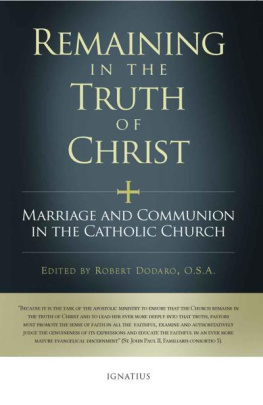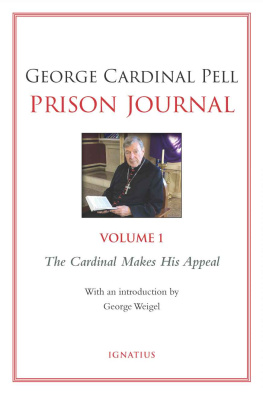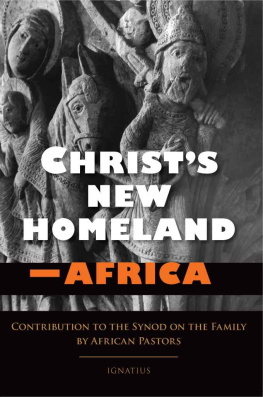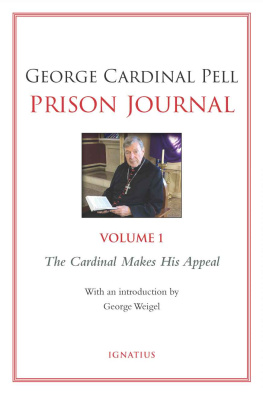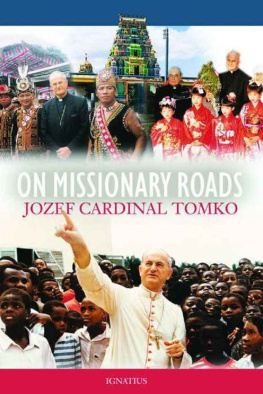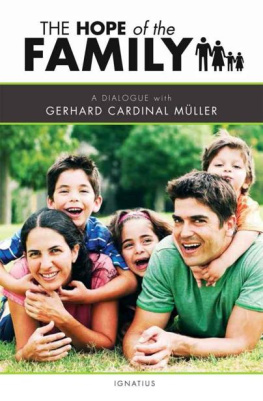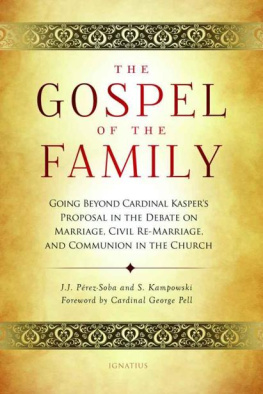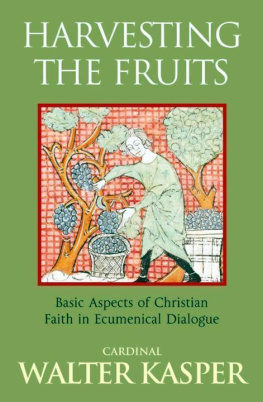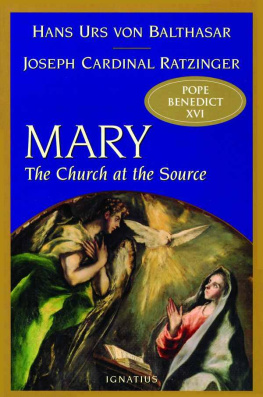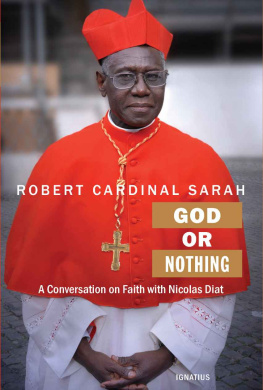REMAINING IN THE
TRUTH OF CHRIST
Remaining in the
Truth of Christ
Marriage and Communion in the
Catholic Church
Edited by
Robert Dodaro, O.S.A .
IGNATIUS PRESS SAN FRANCISCO
Unless otherwise noted, Scripture quotations (except those within citations) have been taken from the Revised Standard Version of the Holy Bible, Second Catholic Edition, 2006. The Revised Standard Version of the Holy Bible: the Old Testament, 1952, 2006; the Apocrypha, 1957, 2006; the New Testament, 1946, 2006; the Catholic Edition of the Old Testament, incorporating the Apocrypha, 1966, 2006; the Catholic Edition of the New Testament, 1965, 2006 by the Division of Christian Education of the National Council of the Churches of Christ in the United States of America.
All rights reserved.
Cover design by Devin Schadt, Saint Louis Creative
2014 by Ignatius Press, San Francisco
All rights reserved
ISBN 978-1-58617-995-3
Library of Congress Control Number 2014943997
Printed in the United States of America
Because it is the task of the apostolic ministry to ensure that the Church remains in the truth of Christ and to lead her ever more deeply into that truth, pastors must promote the sense of faith in all the faithful, examine and authoritatively judge the genuineness of its expressions and educate the faithful in an ever more mature evangelical discernment.St. John Paul II, Familiaris consortio ,
no. 5 (emphasis added)
CONTENTS
1. The Argument in Brief
Robert Dodaro, O.S.A .
2. Dominical Teaching on Divorce and Remarriage: The Biblical Data
Paul Mankowski, S.J .
3. Divorce and Remarriage in the Early Church: Some Historical and Cultural Reflections
John M. Rist
4. Separation, Divorce, Dissolution of the Bond, and Remarriage: Theological and Practical Approaches of the Orthodox Churches
Archbishop Cyril Vasil, S.J .
5. Unity and Indissolubility of Marriage: From the Middle Ages to the Council of Trent
Walter Cardinal Brandmller
6. Testimony to the Power of Grace: On the Indissolubility of Marriage and the Debate concerning the Civilly Remarried and the Sacraments
Gerhard Ludwig Cardinal Mller
7. Sacramental Ontology and the Indissolubility of Marriage
Carlo Cardinal Caffarra
8. The Divorced and Civilly Remarried and the Sacraments of the Eucharist and Penance
Velasio Cardinal De Paolis, C.S .
9. The Canonical Nullity of the Marriage Process as the Search for the Truth
Raymond Leo Cardinal Burke
ACKNOWLEDGMENTS
The Editor gratefully acknowledges the permission granted by the Libreria Editrice Vaticana to publish Testimony to the Power of Grace: On the Indissolubility of Marriage and the Debate Concerning the Civilly Remarried and the Sacraments , by Gerhard Ludwig Cardinal Mller, as well as the magisterial texts published in the appendix of this volume. Libreria Editrice Vaticana. All rights reserved.
1
The Argument in Brief
Robert Dodaro, O.S.A.
The essays in this volume represent the responses of five Cardinals of the Roman Catholic Church and four other scholars to the book The Gospel of the Family , published earlier this year by Walter Cardinal Kasper.
The purpose of the present volume is to answer Cardinal Kaspers invitation for further discussion. The essays published in this volume rebut his specific proposal for a Catholic form of oikonomia in certain cases of divorced, civilly remarried persons on the grounds that it cannot be reconciled with the Catholic doctrine on the indissolubility of marriage, and that it thus reinforces misleading understandings of both fidelity and mercy.
Following this introductory chapter, the volume examines the primary biblical texts concerning divorce and remarriage. The subsequent chapter treats the teaching and practice prevalent in the early Church. In neither of these cases, biblical or patristic, do the authors find support for the kind of toleration of civil marriages following divorce advocated by Cardinal Kasper. Meanwhile, the fourth chapter examines the historical and theological background of the Eastern Orthodox practice of oikonomia , while the fifth chapter traces the centuries-long development in current Roman Catholic teaching on divorce and remarriage. The urgency of these chapters is made clear by Cardinal Kaspers assertions that in regard to the doctrine of the indissolubility of marriage, the tradition in our case is not at all so unilinear, as is often asserted, and that there are historical questions and diverse opinions from serious experts, which one cannot simply disregard. Given the gravity of the doctrinal question involved, these historical claims require a scholarly response.
In the light of the biblical and historical findings of this first part of this volume, the authors of the remaining four chapters reiterate the theological and canonical rationale for maintaining the coherence between Catholic doctrine and sacramental discipline concerning marriage and Holy Communion. The studies included in this book thus lead to the conclusion that the Churchs long-standing fidelity to the truth of marriage constitutes the irrevocable foundation of her merciful, loving response to the individual who is divorced and civilly remarried. This book therefore challenges the premiss that traditional Catholic doctrine and contemporary pastoral practice are in contradiction.
The purpose of this first chapter is to summarize and highlight the principal arguments against Cardinal Kaspers proposal as they are presented in this book.
Divorce and Remarriage in Sacred Scripture
The New Testament records Christ as condemning remarriage after divorce as adultery. In Gospel passages that treat of divorce, the condemnation of remarriage is always absolute (see Mt 5:31-32; 19:3-9; Mk 10:2-12; and Lk 16:18; cf. Lk 5:31-32). Saint Paul echoes this same teaching and insists that it is not his, but Christs: to the married I give charge, not I but the Lord (1 Cor 7:10; emphasis added). The key biblical text from Genesis 2:24 (Therefore a man leaves his father and his mother and cleaves to his wife, and they become one flesh) establishes the truth that marriage is between one man and one woman, that it is only found outside of ones family of origin, that it requires physical intimacy and closeness, and that it results in their becoming one flesh. That this verse represents the true Christian definition of marriage is made clear when Jesus quotes it in his reply to the Pharisees that Moses had permitted divorce as a concession to your hardness of heart,... but from the beginning it was not so (Mt 19:8; cf. Mk 10:5-6; emphasis added). In his explanation to the Pharisees on this occasion (Mk 10:6-9), Jesus alludes both to Genesis 1:27 (from the beginning of creation, God created man in his own image,... male and female he created them) and to Genesis 2:24. Taken together, these passages describe marriage in the original state in which God created it. Jesus point is that the indissolubility of marriage between a man and a woman is founded on a divine law that overrides contemporary Jewish norms concerning divorce: What therefore God has joined together, let not man put asunder (Mk 10:9).
The Exception Clauses in Matthews Gospel
If Jesus teaching concerning divorce and remarriage is so clear, how are we to interpret the two passages in Matthews Gospel that appear to allow divorce in the case of porneia (Mt 5:32; 19:9)? Two authors in this volume directly confront this question. Paul Mankowski, S.J., suggests on philological grounds that porneia may refer not to adultery, as is commonly supposed, but to incest, and perhaps also to polygamy (a practice then current among gentiles). In this case, Mankowski argues that these two passages may represent diriment exceptives inasmuch as they are not exceptions to the rule, but conditions under which the rule does not apply, given that separation between a man and woman in either of these cases does not constitute divorce, there being no real marriage to dissolve.
Next page
